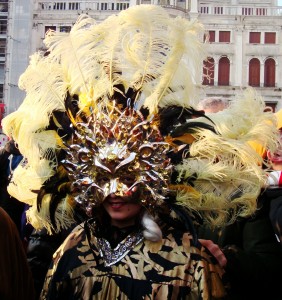2nd entry: On February 12, 2010, I witnessed the first snowfall to blanket Rome since February 1986 (oddly enough, exactly two weeks before I was born). The city was in an uproar: banks closed, traffic was at a standstill, children ran from their classrooms to throw snowballs, and in spite of the icy cobblestones, people flocked to the Vatican to catch a rare glimpse of the Piazza San Pietro covered in white.
And the weekend only got more memorable. 
The following day I hopped on a train from Rome to Venice, where an entirely different sort of uproar had taken over the city: Carnevale! With several friends I spent an entire day and night wandering the streets of Venice in maschera. The crowds were packed with people in lavish costumes—among the traditional Venetian masks and gowns we spotted everything from the Ghostbusters to God to the Mario Brothers. It was incredible to see how much work and creativity was poured into creating these costumes! When night fell Piazza San Marco and the Rialto exploded with live music and dancing. This happened to be my second trip to Venice, but only after this experience did I truly understand the city’s wonder and charm.
 After experiencing Venice’s Carnevale, I decided that I wanted to witness a lesser-known Carnevale for comparison. My curiosity led me to Ivrea, a small town just outside of Torino in Northern Italy. Ivrea celebrates Carnevale with “La Battaglia delle Arance” (the Battle of the Oranges). You won’t believe it until you see it. This battle, representing an uprising of Ivrea’s peasants against their tyrannical overlords in the Middle Ages, takes over the entire town. People on the ground are members of 9 different teams (my personal favorite being named the “Orange Throwers of Death”); these teams ‘fight’ against some two-dozen horse-drawn chariots that ride through the crowded piazzas. What ensues is that the people on the ground, pockets filled to the brim, throw orange after orange at the chariot riders, and vice versa. By the end of the day, I saw many broken noses and fat lips—and the ground was one thick pulpy mess!
After experiencing Venice’s Carnevale, I decided that I wanted to witness a lesser-known Carnevale for comparison. My curiosity led me to Ivrea, a small town just outside of Torino in Northern Italy. Ivrea celebrates Carnevale with “La Battaglia delle Arance” (the Battle of the Oranges). You won’t believe it until you see it. This battle, representing an uprising of Ivrea’s peasants against their tyrannical overlords in the Middle Ages, takes over the entire town. People on the ground are members of 9 different teams (my personal favorite being named the “Orange Throwers of Death”); these teams ‘fight’ against some two-dozen horse-drawn chariots that ride through the crowded piazzas. What ensues is that the people on the ground, pockets filled to the brim, throw orange after orange at the chariot riders, and vice versa. By the end of the day, I saw many broken noses and fat lips—and the ground was one thick pulpy mess!
My research in Art History involves a great deal of reading and translating, analyzing drawings and paintings, and spending many hours in libraries throughout Rome. But I feel as though I’m learning the most from participating in local traditions such as these, which are history in the making. 
